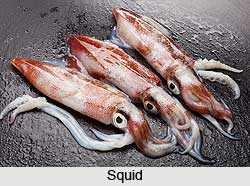 Squids are two-gilled gastropods, free-swimming, very active and gregarious. The common species found around the shores are comparatively small, with body lengths ranging from ten to thirty centimetres, but the species found in Atlantic waters are larger and there are certain giant types measuring ten to fifteen metres. These large squids are the favourable food of sperm whales. Eye-witnesses say that when a whale meets a troop of speeding squids there starts a battle royal, the squids fighting `tooth and nail` with their suckered arms and tentacles but eventually some of them being caught between the powerful jaws of the leviathan.
Squids are two-gilled gastropods, free-swimming, very active and gregarious. The common species found around the shores are comparatively small, with body lengths ranging from ten to thirty centimetres, but the species found in Atlantic waters are larger and there are certain giant types measuring ten to fifteen metres. These large squids are the favourable food of sperm whales. Eye-witnesses say that when a whale meets a troop of speeding squids there starts a battle royal, the squids fighting `tooth and nail` with their suckered arms and tentacles but eventually some of them being caught between the powerful jaws of the leviathan.
A squid can be at once recognized by its long torpedo-shaped body, very like a cuttlefish, except that its fins are triangular. It has a distinct head region with a pair of prominent eyes. There are eight stumpy arms carrying disc-shaped suckers. There is an additional pair of very long tentacular arms whose extremities are swollen and socker-clad. All these ten arms are arranged in a circle round the mouth of the animal. The tentacular arms can be withdrawn into a pouch on either side of the head. Squids seize their prey, mainly small fishes, by encircling them with their long tentacles and then eat them with the help of the sharp horny beaks set around their mouth. Like the octopus, the squid has also no external shell but it has an internal support called the `pen` in the dorsal region. The pen is a thin horny structure almost transparent. A muscular mantle covers the body.
Squids are jet-propelled. They swim by ejecting a stream of water from the gill chamber through a siphon on the underside of their body. This shoots them backwards with astonishing speed, the squid`s body being shaped to offer little resistance when propelled under water. Squids do not build individual shelters as octopuses do but are vagabonds, moving in schools from place to place in coastal waters. In calm weather they enter inshore waters in great shoals, and are found in plenty in deep embayments such as the Gulf of Kutch, parts of the Gulf of Mannar and in Palk Bay. During the southwest monsoon, when the southern waters are rough, they enter in great schools into the protected shallow waters around Rameshwaram partly to feed on the small fry that seek shelter in shallows from the violence of the waves and partly to lay their eggs on the thick growths of seaweeds abundant at that place.
As in all cephalopods, the sexes are separate. The ova are contained in small cylindrical cases measuring seven to ten centimetres and the number of ova is about two hundred and fifty in each case. Hundreds of these cases are attached together like a bundle of sausages or young carrots. The total number of eggs range from thirty thousand to forty thousand. The eggs of squids develop in the same manner as the eggs of Cuttlefishes. It is doubtful if all the ova in a capsule become fully developed due to limited accommodation in the capsule. Even if all of them come out as young adults many are eaten by other sea animals.
Squids are prized as food. They are fished by using suitable nets or by long jiggers (hooked poles three to four metres long). Squids thus collected are split, dried in the sun and sold for food. The common Indian species are Loligo indica and Sepioteuthis arctipinnis. Excluding the tentacular arms the body-length with the head and arms measures sixteen centimetres in Loligo, twenty four centimetres in the other.



















